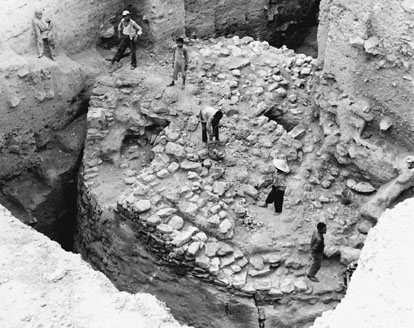

 | Page 763 |  |
She was the first honorary secretary of that institute, was its acting director from 1942 to 1946, and from 1948 to 1962 held the lectureship in Near Eastern Archaeology there. She then served as principal of St. Hugh’s College, Oxford, until her retirement in 1973.

Jordanian archaeological workers excavating a tower near the Dead Sea believed to date to 7000 B.C.
(© Bettmann/CORBIS)
Apart from her extensive work on Romano-British sites and in Zimbabwe and Samaria during the 1930s and 1940s, Kenyon conducted major archaeological expeditions at the Roman town of Sabratha in Tripolitania (Libya in north Africa) and at two famous biblical sites in Palestine, Jericho (1952–1958) and Jerusalem (1961– 1967). It was her pioneering work in uncovering the earliest known stages in the history of mankind at Jericho that made Kenyon world famous as both a personality and an archaeologist. Her last fieldwork on Mt. Ophel in the 1970s, the biblical site of Jerusalem, was conducted as a rescue operation because of urban development in East Jerusalem. The work served as the basis for Kenyon’s being able to correct and clarify much of the nonstratigraphical work carried out in Jerusalem during the nineteenth century.
Kenyon received many honors during her long and distinguished career, which culminated in her being created a Dame Commander of the Order of the British Empire in 1973. She wrote many archaeological articles and excavation reports, the most widely read being Archaeology in the Holy Land (1st ed., 1960; 4th ed., 1979), which has been translated into a number of foreign languages.
References
For references, see Encyclopedia of Archaeology: The Great Archaeologists, Vol. 2, ed. Tim Murray (Santa Barbara, CA: ABC-CLIO, 1999), pp. 491–493.
 |  |